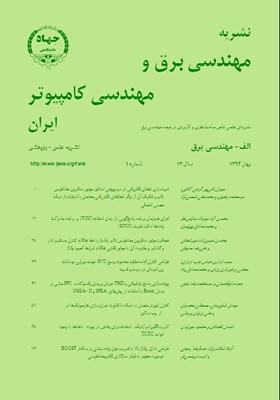بهینهسازی پاسخ دینامیکی و THD جریان ورودی یکسوکننده PFC مبتنی بر مبدل Boost با استفاده از روشهای SPEA و NSGA - II
محورهای موضوعی : مهندسی برق و کامپیوترحمیده ابوالحسنی 1 , سیدمحمدرضا رفیعی 2
1 - دانشگاه آزاد اسلامی واحد گرمسار
2 - دانشگاه آزاد اسلامی واحد گرمسار
کلید واژه: بهینهسازی چندهدفه پاسخ دینامیکی مرتبه کسری مرتبه صحیح,
چکیده مقاله :
در مبدلهای تصحیح ضریب توان تکمرحلهای تکفاز، زمان رسیدن به پاسخ دینامیکی با THD جریان ورودی متضاد میباشند. هدف اصلی این مقاله بهبود پاسخ دینامیکی این مبدلها در کنار کاهش THD جریان ورودی است و برای رسیدن به این هدف از روشهای بهینهسازی چندهدفه SPEA و NSGA-II که مبتنی بر الگوریتمهای تکاملی هستند برای طراحی ضرایب جبرانکننده PI به کار رفته در روش کنترلی جریان غیر مستقیم یکسوکننده PFC استفاده شده است. ابتدا جبرانکننده PI مرتبه صحیح و سپس جبرانکننده PI مرتبه کسری طراحی شد و نتایج به دست آمده نشاندهنده برتری جبرانکننده PI مرتبه کسری بود. برای بررسی مسئله بهینهسازی، پاسخ دینامیکی به تغییرات در بار و ولتاژ مرجع در نظر گرفته شد و همچنین از مقایسه بین دو الگوریتم به کار رفته برای بهینهسازی مشخص شد که با تغییر توابع هدف، هر کدام از الگوریتمها ممکن است عملکرد خوبی داشته باشد و هیچ کدام بر دیگری برتری مطلق ندارد.
In single-stage single-phase power factor correction converters, the time of dynamic response and input current THD are in conflict with each other. The main purpose of this paper is to improve the dynamic response of the converter along with reducing its input current THD. To achieve these goals, two multi-objective optimization methods based on evolutionary algorithms including; SPEA and NSGA-II were used to design a PI compensator coefficients in the indirect current control technique for PFC rectifier. The integral and fractional-order PI compensators were designed, respectively. The obtained results showed the superiority of the fractional-order PI compensator. To investigate the optimization problem, the dynamic response to changes in load and reference voltage was considered. The comparison between the optimization algorithms showed that each algorithm may have better performance than the other one according to the used objective functions. It means that neither had an absolute superiority.
[1] V. Tuomainen, Low - Power PFC and Forward Converters Methods to Improve Performance, Thesis for Ph.D Helsinki University of Technology, 2004.
[2] R. Ghosh and G. Narayanan, "A simple method to improve the dynamic response of single - phase PWM rectifiers," IEEE Trans. on Industrial Electronics, vol. 55, no. 10, pp. 3627-3634, Oct. 2008.
[3] G. Spiazzi, P. Mattavelli, and L. Rossetto, "Power factor preregulators with improved dynamic response," IEEE Trans. Power Electron., vol. 12, no. 2, pp. 343-349, Mar. 1997.
[4] A. Prodic, J. Chen, R. W. Erikson, and D. Maksimovic, "Digitally controlled low - harmonic rectifier having fast dynamics responses," in Proc. IEEE APEC, vol. 1, pp. 476-482, Mar. 2002.
[5] A. Prodic, J. Chen, D. Maksimovic, and R. W. Erickson, "Self - tuning digitally controlled low-harmonic rectifier having fast dynamics responses," IEEE Trans. Power Electron., vol. 18, no. 1, pp. 420-428, Jan. 2003.
[6] A. Prodic, D. Maksimovic, and R. W. Erickson, "Dead - zone digital controllers for improved dynamic response of low harmonic rectifiers," IEEE Trans. Power Electron., vol. 21, no. 1, pp. 173-181, Jan. 2006.
[7] M. O. Eissa, S. B. Leeb, G. C. Verghese, and A. M. Slankovic, "A fast analog controller for a unity - power factor AC/DC convener," in Proc. IEEE APEC'94, vol. 2, pp. 551-555, Feb. 1994.
[8] E. Figueres, J. M. Benavent, G. Garcera, and M. Pascual, "Robust control of power - factor - correction rectifiers with fast dynamic response," IEEE Trans. Ind. Electron., vol. 52, no. 1, pp. 66-76, Feb. 2005.
[9] E. Figueres, J. M. Benavent, G. Garcera, and M. Pascual, "A control circuit with load current injection for single - phase power factor correction rectifiers," IEEE Trans. Ind. Electron., vol. 54, no. 3, pp. 1272-1281, Feb. 2005.
[10] A. Amirahmadi, A. Dastfan, and M. R. Rafiei, "Optimal controller design for single - phase PFC rectifiers using SPEA multi - objective optimization," J. of Power Electronics, vol. 12, no. 1, pp. 104-112, 2012.
[11] A. Amirahmadi, A. Dastfan, H. Yassami, and S. M. R. Rafiei, "Multi-objective optimum design of controller for PFC rectifier using NSGA-II algorithm," in Proc. Power Electronics, Drive Systems & Technologies Conf., PEDSTC'10, pp. 180-185, 17-18 Feb. 2010.
[12] C. A. Coello Coello, Twenty Years of Evolutionary Multi-Objective Optimization: A Historical View of the Field, Evolutionary Computation Group, Departamento de Ingeniería Eléctrica Sección de Computación. Av. Instituto Politécnico Nacional No. 2508, 20 pp., 2005.
[13] E. Zitzler and L. Thiele, "Multiobjective optimization using evolutionary algorithms - a comparative study," in A. E. Eiben, Editor, Parallel Problem Solving from Nature V, Amsterdam, Springer-Verlag, pp. 292-301, 1998.
[14] E. Zitzler and L. Thiele, "Multiobjective evolutionary algorithms: a comparative case study and the strength pareto approach," IEEE Trans. on Evolutionary Computation, vol. 3, no. 4, pp. 257-271, Nov. 1999.
[15] I. F. Sbalzarini, S. Muller, and P. Koumoutsakosyz, "Multiobjective optimization using evolutionary algorithms," in Proc. of the Summer Program, Center for Turbulence Research, pp. 63-74, 2000.
[16] E. Zitzler, Evolutionary Algorithms for Multiobjective Optimization: Methods and Applications, Ph.D Thesis, Swiss Federal Institute of Technology Zurich, 1999.
[17] I. Petras, Fractional-Order Nonlinear Systems, Modeling, Analysis and Simulations, Springer, 2010.
[18] I. Petras, L. Dorcak, and I. Kostial, "Control quality enhancement by fractional order controllers," Acta Montanistica Slovaca Rocnik, vol. 3, no. 2, pp. 143-148, 1998.


